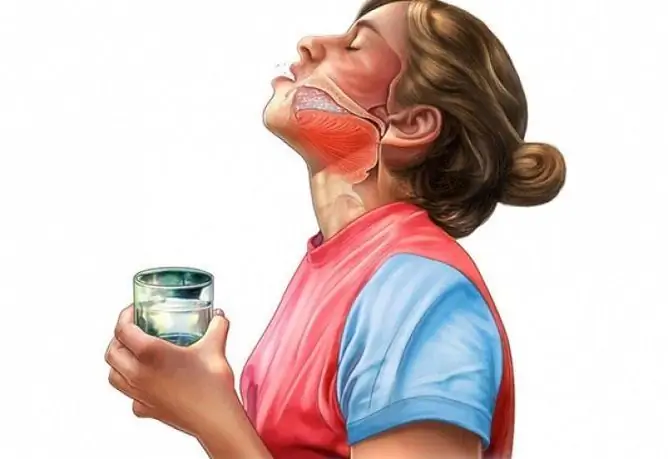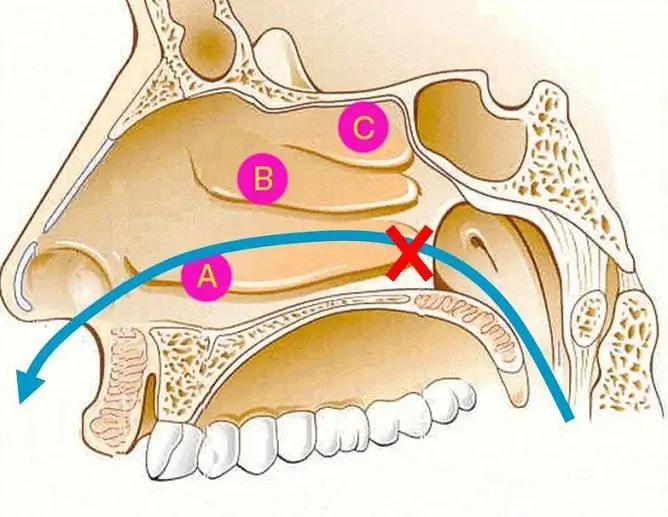- Author Rachel Wainwright [email protected].
- Public 2023-12-15 07:39.
- Last modified 2025-11-02 20:14.
Rosacea
Brief description of the disease

Rosacea is a disease associated with vascular damage in the trigeminal nerve region. The causes of the disease are disorders of the gastrointestinal tract and endocrine system, climatic factors, stress and emotional stress, neurological disorders. An exacerbation of the disease can be caused by prolonged exposure to the sun or frost, overly spicy food, visiting a sauna or bath. In addition, rosacea, the symptoms of which are most often manifested in middle-aged and elderly people, is often accompanied by the appearance of mites - demodexes, which settle in human hair follicles and skin glands. When in contact with the skin, mites begin to multiply rapidly and aggravate the patient's condition.
During the exacerbation period, patients complain of itching and hot flashes of the skin. Note also that rosacea, which was not treated or was carried out superficially, leads to cyanosis of the skin, venous stasis in the skin, vasodilation and the appearance of new lesions. In especially severe cases, the patient develops rhinophyma. Sometimes the eyes are affected in sick people. They turn red, begin to tear and dry.
Rosacea - symptoms and stages of the disease
Most often, the disease manifests itself on the skin of the face. The leading symptom indicating vascular damage is the presence of erythema (redness of the skin). Later, the patient develops acne and papular elements. The course of the disease can be divided into several stages:
- erythematous - there is an expansion of capillaries and concomitant redness of the skin. These violations affect almost the entire area of the skin of the face, sometimes spread to the neck and chest;
- papular - characterized by the appearance of at first single, and then quite abundant red nodules of a spherical shape;
- pustular - acne occurs, hypertrophy of the sebaceous glands develops;
- nodal stage - rhinophyma appears - proliferation of the connective tissue of the skin of the nose, the formation of lumpy, lobular nodes on its surface.
Rosacea - treatment of the disease

First of all, the patient should avoid situations that cause blood flow to the skin of the face. Stay in frost and sun, in a bathhouse, too hot rooms should be limited, avoid eating too hot food, spicy foods and alcoholic beverages. In addition, it is better to give up massage and thermal procedures on the skin for a while.
If a person is diagnosed with rosacea, folk remedies should be used in conjunction with traditional treatments. Good results are shown by cryotherapy, electrocoagulation and dermabrasion (a cosmetological procedure consisting in mechanical skin resurfacing using special equipment). One should start with antidemodicosis therapy, for which liquid nitrogen is used, treatment according to the Demyanochiv method, and sulfur tar alcohol.
If a person has pronounced inflammatory rosacea, treatment is based on the use of corticosteroid ointments. Cooling lotions are also recommended: 1-2% resorcinol solution, 3% boric acid solution, extracts of chamomile, celandine and calendula. In the presence of papular-pustular rashes, it is advisable to temporarily stop washing and wipe the skin with disinfecting and drying compositions.
Rosacea - treatment with folk remedies
To get rid of skin redness and acne, traditional medicine uses topical local methods, in particular, lotions, masks, wipes and products that have a disinfectant or anti-inflammatory effect.
With redness and swelling of the skin, which is usually accompanied by rosacea, alternative treatment recommends using cold lotions based on infusions of string, yarrow, parsley and chamomile flowers. Propolis shows very high efficiency, a 5% solution of which is used to wipe the face before going to bed. Consider only that a thin film will appear on your face the next morning. It can be removed with a cotton swab dipped in vodka.
What if a person develops acne rosacea? Folk remedies traditionally used for acne are masks:
- mask with aloe juice - dilute aloe juice in warm water in a 1: 1 ratio and moisten gauze napkins with this mixture, which are then applied to the face for 20 minutes. The course of treatment lasts 15-20 days;
- mask with cabbage juice - the sequence of actions is the same as in the case of aloe mask, but cabbage juice is used as the main ingredient;
- mask with rosehip infusion - wipes are moistened with warm rosehip infusion. Within 20 minutes, while the mask is on the face, they must be replaced 6-7 times. The procedure is performed every other day 20 times.
To increase the effectiveness of alternative treatment of rosaceia, masks can be combined with ingestion of a collection consisting of burdock stems, horsetail herb and nettle leaves. To prepare the broth, take 2 tbsp. collection spoons and fill them with 0.5 liters. water. The mixture is infused for 5 minutes over low heat. The broth is taken 4 times a day. The dosage is half a glass.
YouTube video related to the article:
The information is generalized and provided for informational purposes only. At the first sign of illness, see your doctor. Self-medication is hazardous to health!






